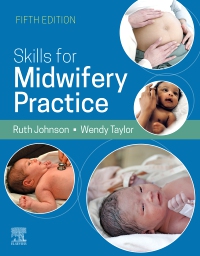
Skills for Midwifery Practice - Elsevier eBook on VitalSource, 5th Edition
Elsevier eBook on VitalSource

Now $39.89
Skills for Midwifery Practice is the go-to book for all midwifery students who need to learn what to do in a range of situations, how to perform a skill, and why they need to do it in a certain way.
Written by midwifery educators Ruth Johnson and Wendy Taylor, the book makes learning easy with background information, learning outcomes, helpful diagrams and lists to represent the skill flow. It explains the underlying physiology associated with pregnancy and childbirth, and clearly defines the nature and extent of current practice.
This version is fully updated and referenced throughout to provide a detailed evidence base to support learning and further study. It is ideal for midwives in training, qualified midwives returning to practice, as well as other members of the obstetric healthcare team.
-
- Clear and logical – easy to follow and understand for training midwives
- Accurate, up-to-date evidence base that is relevant to contemporary midwifery practice
- Each skill contextualized with background, indications and contraindications to support both clinical practice and study
- Learning objectives and end-of-chapter self-assessment exercises allow readers to monitor their progress
- Latest guidelines and standards
- New information on resuscitation and other emergencies
- Now in full color throughout
- Expanded chapter on the use of standard precautions in light of the global pandemic
- Developed discussion of alternative feeding methods
-
1. Principles of abdominal examination: during pregnancy and labour
2. Principles of abdominal examination: during the postnatal period
3. Assessment of maternal and neonatal vital signs: temperature measurement
4. Assessment of maternal and neonatal vital signs: pulse measurement
5. Assessment of maternal and neonatal vital signs: blood pressure measurement
6. Assessment of maternal and neonatal vital signs: respiration
7. Assessment of maternal and neonatal vital signs: neurological assessment
8. Principles of infection control: standard precautions
9. Principles of infection control: hand hygiene
10. Principles of infection control: principles of asepsis
11. Principles of infection control: obtaining swabs
12. Principles of hygiene needs: for the woman
13. Principles of hygiene needs: for the baby
14. Principles of elimination management: micturition and catheterization
15. Principles of elimination management: urinalysis
16. Principles of elimination management: defaecation
17. Principles of elimination management: obtaining urinary and stool specimens
18. Principles of drug administration: legal aspects, pharmacokinetics and anaphylaxis
19. Principles of drug administration: oral administration
20. Principles of drug administration: injection technique
21. Principles of drug administration: administration of medicines per vaginam
22. Principles of drug administration: administration of medicines per rectum
23. Principles of drug administration: intravenous drug administration
24. Principles of drug administration: inhalational analgesia: Entonox
25. Principles of drug administration: epidural analgesia
26. Principles of drug administration: transcutaneous electrical nerve stimulation
27. Facilitation of skills related to childbearing: optimal fetal positioning
28. Facilitation of skills related to childbearing: Cusco speculum use
29. Facilitation of skills related to childbearing: membrane sweep
30. Principles of intrapartum skills: first-stage issues
31. Principles of intrapartum skills: second-stage issues
32. Principles of intrapartum skills: third-stage issues
33. Principles of intrapartum skills: examination of the placenta
34. Principles of intrapartum skills: perineal repair
35. Principles of intrapartum skills: management of birth at home
36. Principles of intrapartum skills: management of labour and birth in water
37. Assessment of the baby: assessment at birth
38. Assessment of the baby: daily examination
39. Assessment of the baby: capillary sampling
40. Assessment of the baby: developmental dysplasia of the hips
41. Principles of infant nutrition: breastfeeding
42. Principles of infant nutrition: cup feeding
43. Principles of infant nutrition: decontamination of feeding equipment
44. Principles of infant nutrition: formula feeding
45. Principles of infant nutrition: nasogastric feeding
46. Principles of phlebotomy and intravenous therapy: maternal venepuncture
47. Principles of phlebotomy and intravenous therapy: intravenous cannulation
48. Principles of phlebotomy and intravenous therapy: intravenous infusion
49. Principles of phlebotomy and intravenous infusion: blood transfusion
50. Principles of manual handling
51. Principles of perioperative skills
52. Principles of wound management: healing and care
53. Principles of restricted mobility management: pressure area care
54. Principles of restricted mobility management: prevention of venous thromboembolism
55. Principles of cardiopulmonary resuscitation: maternal resuscitation
56. Principles of cardiopulmonary resuscitation: neonatal resuscitation
57. Glossary

 as described in our
as described in our 